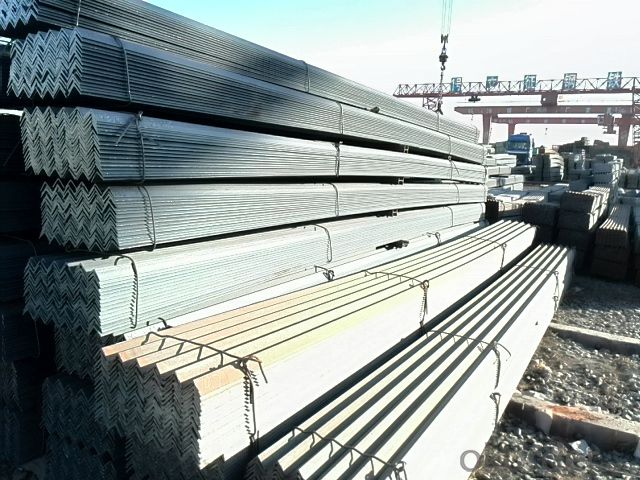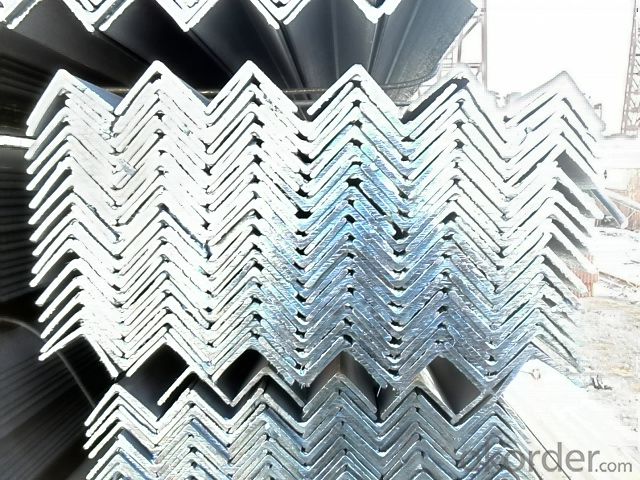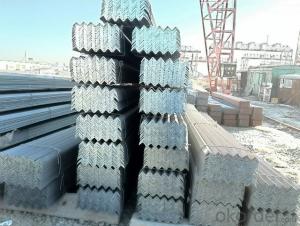Hot Rolled Steel Angle Bars in Grade Q235
- Loading Port:
- Tianjin
- Payment Terms:
- TT OR LC
- Min Order Qty:
- 25 m.t
- Supply Capability:
- 10000 m.t/month
OKorder Service Pledge
OKorder Financial Service
You Might Also Like
Item specifice
Okorder.com is a professional materials & equipment supplier & manufacturer, offers integrated one-stop services including real-time quoting and online cargo tracking. We are funded by CNBM Group, a Fortune 500 enterprise and the largest materials & equipment firm in China.
Product Applications:
According to the needs of different structures, Angle can compose to different force support component, and also can be the connections between components. It is widely used in various building structures and engineering structures such as roof beams, bridges, transmission towers, hoisting machinery and transport machinery, ships, industrial furnaces, reaction tower, container frame and warehouse etc.
Product Advantages:
OKorder's Steel Angles are durable, strong, and resist corrosion.
Main Product Features:
· Premium quality
· Prompt delivery & seaworthy packing (30-45 days after receiving deposit)
· Corrosion resistance
· Can be recycled and reused
· Mill test certification
· Professional Service
· Competitive pricing
Product Specifications:
1. Invoicing on theoretical weight or actual weight as customer request
2. Length: 6m, 9m, 12m as following table
3. Sizes

Sizes: 25mm-250mm | ||
a*t | ||
25*2.5-4.0 | 70*6.0-9.0 | 130*9.0-15 |
30*2.5-6.6 | 75*6.0-9.0 | 140*10-14 |
36*3.0-5.0 | 80*5.0-10 | 150*10-20 |
38*2.3-6.0 | 90*7.0-10 | 160*10-16 |
40*3.0-5.0 | 100*6.0-12 | 175*12-15 |
45*4.0-6.0 | 110*8.0-10 | 180*12-18 |
50*4.0-6.0 | 120*6.0-15 | 200*14-25 |
60*4.0-8.0 | 125*8.0-14 | 250*25 |
4.Material details:
Alloy No | Grade | Element (%) | |||||
C | Mn | S | P | Si | |||
|
|
|
|
|
|
| |
Q235 | B | 0.12—0.20 | 0.3—0.7 | ≤0.045 | ≤0.045 | ≤0.3 | |
|
|
|
|
|
|
| |
Alloy No | Grade | Yielding strength point( Mpa) | |||||
Thickness (mm) | |||||||
≤16 | >16--40 | >40--60 | >60--100 | ||||
≥ | |||||||
|
|
|
|
|
| ||
Q235 | B | 235 | 225 | 215 | 205 | ||
Alloy No | Grade | Tensile strength (Mpa) | Elongation after fracture (%) | ||||
Thickness (mm) | |||||||
| ≤16 | >16--40 | >40--60 | >60--100 | |||
≥ | |||||||
|
|
|
|
|
|
| |
Q235 | B | 375--500 | 26 | 25 | 24 | 23 | |
FAQ:
Q1.What's your payment terms ?
A1:1)100% irrevocable L/C at sight.
2)30% T/T prepaid and the balance against the copy of B/L.
3)30% T/T prepaid and the balance against L/C
4)100% irrevocable L/C at 90/120/180 sight.
Q2: The products are invoicing on theoretical weight or on actual weight?
A2: We can do it in both manners, it’s according to buyer's requirement.
Q3: Can fit in the containers of 20fts for 6M long ?
A3: Yes, we can put them into the containers in the form sideling, in this way we can save the buyer much ocean freight.
Images:


- Q:What are the limitations of using steel angles?
- The use of steel angles in various applications comes with several limitations. Firstly, their load-bearing capacity is limited and depends on factors such as size, shape, and material composition. If the load exceeds the angle's capacity, it can cause structural failure or deformation. Secondly, steel angles are prone to corrosion. As they are typically made of carbon steel, exposure to moisture or corrosive environments can lead to rust formation. This weakens the angle's structural integrity, reduces its lifespan, and potentially compromises the overall stability of the supported structure. Moreover, steel angles may have restrictions on flexibility and versatility. Their fixed shape and size may not be suitable for applications that require intricate or complex designs. In such cases, alternative materials or fabrication methods may be more appropriate. Another limitation is the limited fire resistance of steel angles. When exposed to high temperatures, steel, including steel angles, loses its strength and structural integrity. In the event of a fire, steel angles may deform or collapse, posing a safety risk to the structure and its occupants. Lastly, the installation or modification of steel angles can be challenging. Their rigid nature often necessitates specialized tools, equipment, or expertise for tasks like cutting, drilling, or welding. This can increase the overall cost and time required for construction or renovation projects. Despite these limitations, steel angles remain widely used due to their affordability, durability, and versatility within their design limits. However, it is crucial to consider these limitations and assess the specific requirements of each application to determine if steel angles are the most suitable option.
- Q:How are steel angles supported during installation?
- Steel angles are typically supported during installation using structural supports such as brackets, beams, or frames. These supports ensure the angles are securely held in place, allowing for proper alignment and stability.
- Q:Can steel angles be used as a support for shelving?
- Yes, steel angles can be used as a support for shelving. Steel angles are sturdy and durable, making them suitable for bearing the weight of shelves and providing structural support.
- Q:How do you store and transport steel angles?
- In order to ensure the safety and prevent damage of steel angles during storage and transportation, it is crucial to adhere to specific guidelines. Consider the following steps: 1. Find an appropriate storage location: Locate a well-ventilated, dry, and clean area that is free from moisture or chemicals that may cause corrosion. Ideally, choose an indoor storage area to shield the steel angles from the elements. 2. Properly organize and stack: Prioritize organizing the steel angles according to their size, shape, and weight. Stack them horizontally, one on top of another, with heavier angles at the bottom to prevent deformation or damage to lighter ones. Insert wooden or rubber spacers between layers to minimize direct contact and reduce the risk of scratches or other surface flaws. 3. Secure the stack: Use strong metal bands, straps, or chains to tightly bind the stack of steel angles. This will prevent movement during transportation and decrease the chances of accidents or damage. 4. Utilize appropriate lifting equipment: When handling steel angles, it is crucial to employ suitable lifting equipment such as cranes, forklifts, or hoists. Ensure that the equipment has the necessary capacity to safely lift the angles and distribute the lifting points evenly to avoid bending or distortion. 5. Guard against corrosion: Prior to storage and transportation, apply a corrosion-resistant coating or protective oil film to the steel angles. This will help prevent rusting and other forms of corrosion caused by exposure to moisture or environmental factors. 6. Secure packaging during transportation: If the steel angles need to be transported over long distances, consider using appropriate packaging materials like wooden crates or steel pallets to provide additional protection. Fasten the angles securely to the packaging to prevent any movement or shifting during transit. 7. Regularly inspect: Conduct regular inspections of the stored and transported steel angles to identify any signs of corrosion, damage, or deformation. Take immediate action to prevent further deterioration if any issues are detected. By adhering to these guidelines, you can ensure the safe storage and transportation of steel angles, thereby minimizing the risk of damage and preserving their quality.
- Q:What are the different standards for steel angles?
- There are several different standards for steel angles, which are commonly used in construction and industrial applications. One of the most widely recognized standards is the American Society for Testing and Materials (ASTM) standard. ASTM A36 is a common grade for steel angles and specifies the chemical composition, mechanical properties, and tolerances for these structural shapes. It is commonly used for general structural purposes and is available in various sizes and lengths. Another prominent standard is the European standard, known as EN 10025. This standard includes several grades of steel angles, such as S235, S275, and S355, which correspond to different yield strengths. EN 10025 steel angles are widely used in construction, machinery, and engineering industries across Europe. In addition to these standards, there are also country-specific standards, such as the Japanese Industrial Standards (JIS) and the British Standards (BS). JIS G3101 is a well-known standard in Japan, which specifies the hot-rolled steel angles for general structures. BS EN 10056 is a British standard that provides specifications for steel angles used in construction. Furthermore, there are specialized standards for specific applications, such as marine-grade steel angles that are resistant to corrosion in saltwater environments. These standards, like ASTM A588, provide additional requirements for chemical composition and mechanical properties to ensure the steel angles' durability in harsh conditions. Overall, the different standards for steel angles ensure that these structural shapes meet specific requirements for strength, durability, and compatibility with various construction and industrial applications. It is crucial to refer to the appropriate standard when selecting steel angles to ensure they meet the necessary specifications for the intended use.
- Q:Are steel angles vulnerable to rusting?
- Certainly, rusting can affect steel angles. Steel, being predominantly composed of iron, is greatly prone to rusting upon exposure to moisture and oxygen. In the absence of a reliable corrosion-resistant coating or paint, it is highly likely for the steel angles to gradually accumulate rust. This rust accumulation can diminish the angles' structural durability, ultimately undermining their effectiveness. In order to minimize the risk of rusting and extend the lifespan of steel angles, it is important to regularly maintain them and employ suitable rust prevention measures such as painting or galvanizing.
- Q:How do steel angles contribute to architectural design?
- Architectural design relies heavily on steel angles due to their ability to offer both structural stability and design flexibility. These angled steel profiles are commonly utilized in various construction projects, including buildings, bridges, and other structures, to provide support and reinforcement. A significant advantage of steel angles in architectural design lies in their capacity to enhance the structural integrity of a building. By creating rigid connections between different structural elements, these angles add strength and stability to the overall structure, enabling it to withstand different loads and forces. This is especially crucial in high-rise buildings or structures situated in areas prone to earthquakes or strong winds. Furthermore, steel angles empower architects and designers to create distinctive and innovative architectural features. Their versatility allows for the development of aesthetically pleasing designs, such as cantilevered balconies, intricate facades, and unique rooflines. Due to their ability to be easily manipulated and welded, steel angles are well-suited for complex geometric shapes and creative design concepts. Moreover, steel angles offer cost-effective solutions in architectural design. They are readily available in various sizes and lengths, making them easily obtainable and integratable into construction projects. Their durability and low-maintenance properties make them a long-lasting and economical choice for architects, reducing the need for frequent repairs or replacements. Additionally, steel angles contribute to sustainability in architectural design. Steel is a highly recyclable material, and incorporating steel angles into construction projects reduces the demand for new materials. Additionally, the lightweight nature of steel angles allows for efficient transportation, reducing carbon emissions during the construction process. In conclusion, steel angles are indispensable in modern architectural design due to their ability to provide structural support, design flexibility, cost-effectiveness, and sustainability. Their usage not only enhances the overall strength and stability of a structure but also enables architects to create visually appealing and unique designs. With their numerous benefits, steel angles have become an integral element in contemporary architectural design.
- Q:Can steel angles be galvanized?
- Yes, steel angles can be galvanized. Galvanizing is a process in which a protective zinc coating is applied to steel to prevent corrosion. Steel angles are commonly galvanized to enhance their durability and resistance to rust and other forms of degradation.
- Q:What are the common welding techniques used for steel angles?
- The common welding techniques used for steel angles include shielded metal arc welding (SMAW), gas metal arc welding (GMAW), and flux-cored arc welding (FCAW).
- Q:How are steel angles welded or joined together?
- Steel angles can be welded or joined together using various techniques such as arc welding, MIG welding, or TIG welding. These methods involve melting and fusing the steel angles together to form a strong and durable joint. Additionally, other joining methods like bolting or riveting can also be used to connect steel angles, depending on the specific application and requirements.
1. Manufacturer Overview |
|
|---|---|
| Location | |
| Year Established | |
| Annual Output Value | |
| Main Markets | |
| Company Certifications | |
2. Manufacturer Certificates |
|
|---|---|
| a) Certification Name | |
| Range | |
| Reference | |
| Validity Period | |
3. Manufacturer Capability |
|
|---|---|
| a)Trade Capacity | |
| Nearest Port | |
| Export Percentage | |
| No.of Employees in Trade Department | |
| Language Spoken: | |
| b)Factory Information | |
| Factory Size: | |
| No. of Production Lines | |
| Contract Manufacturing | |
| Product Price Range | |
Send your message to us
Hot Rolled Steel Angle Bars in Grade Q235
- Loading Port:
- Tianjin
- Payment Terms:
- TT OR LC
- Min Order Qty:
- 25 m.t
- Supply Capability:
- 10000 m.t/month
OKorder Service Pledge
OKorder Financial Service
Similar products
New products
Hot products
Related keywords




























